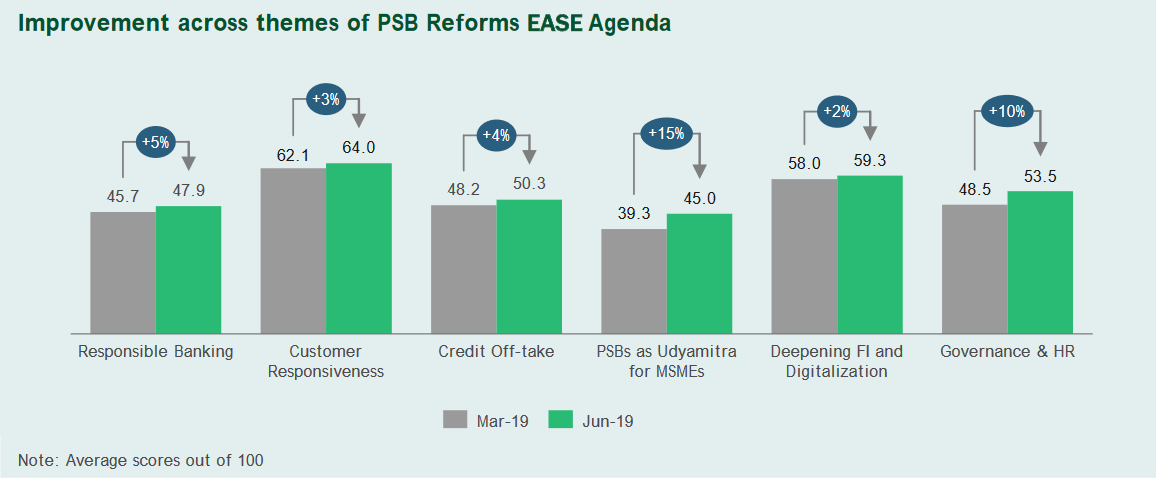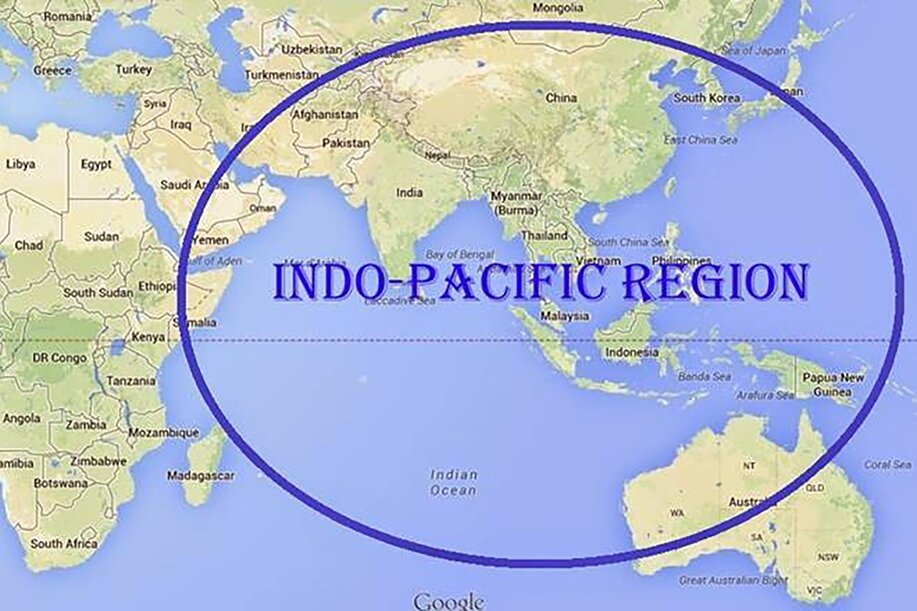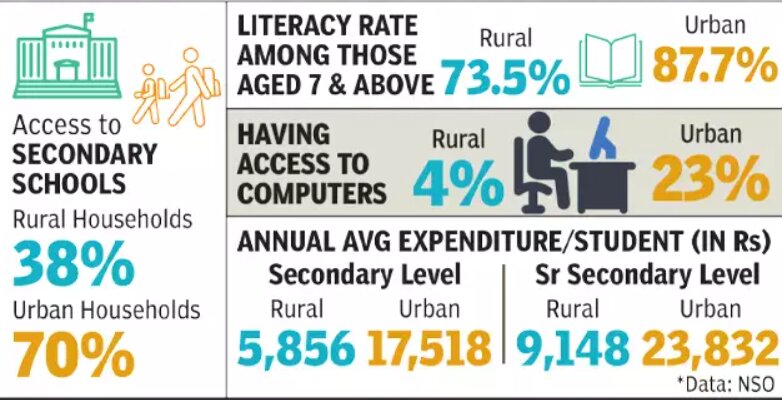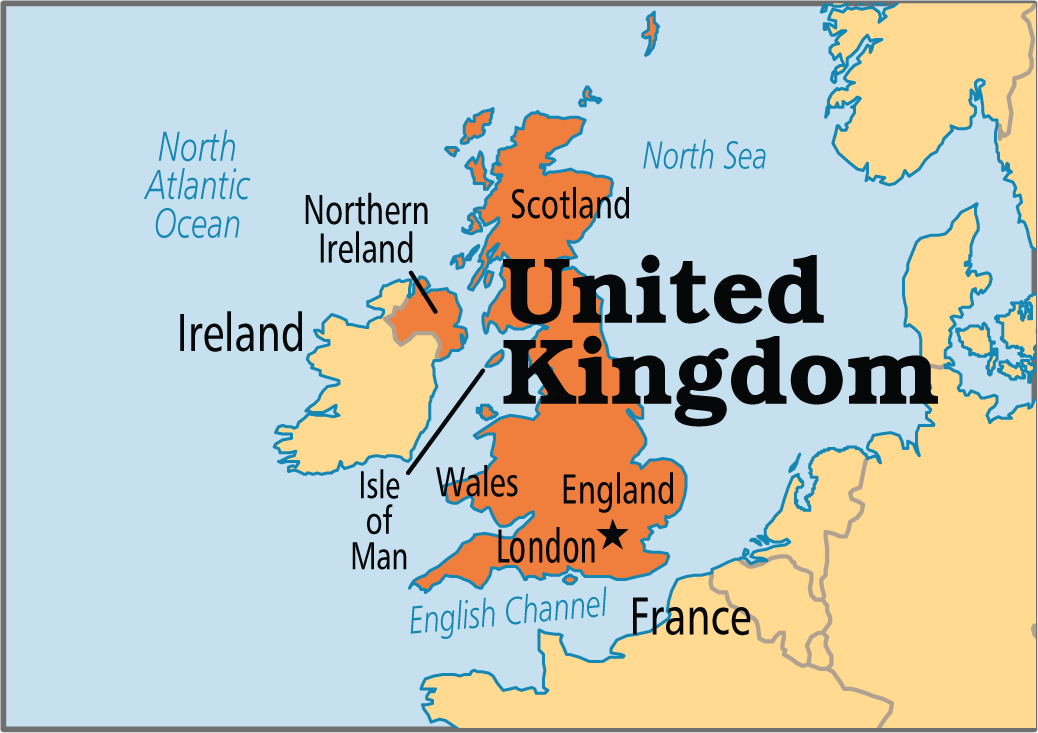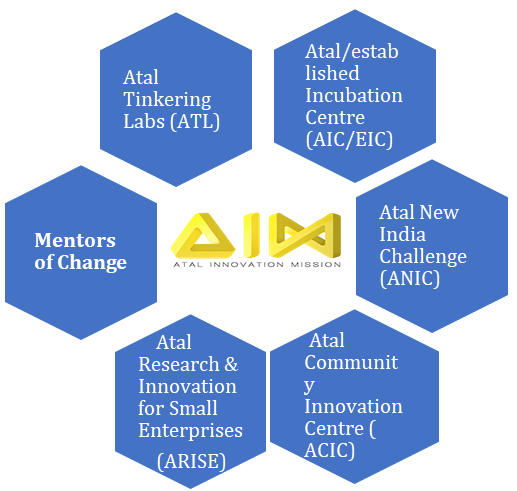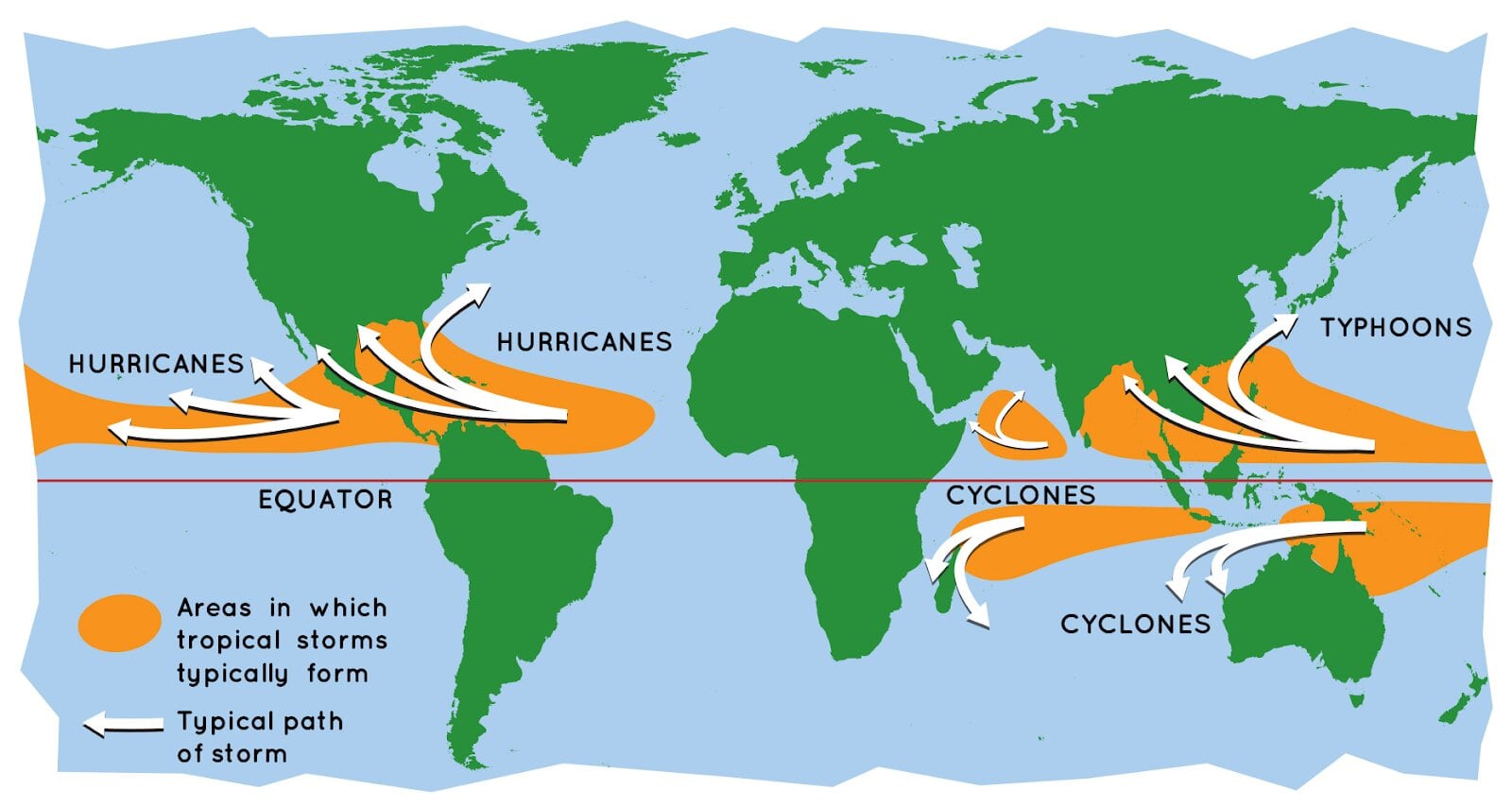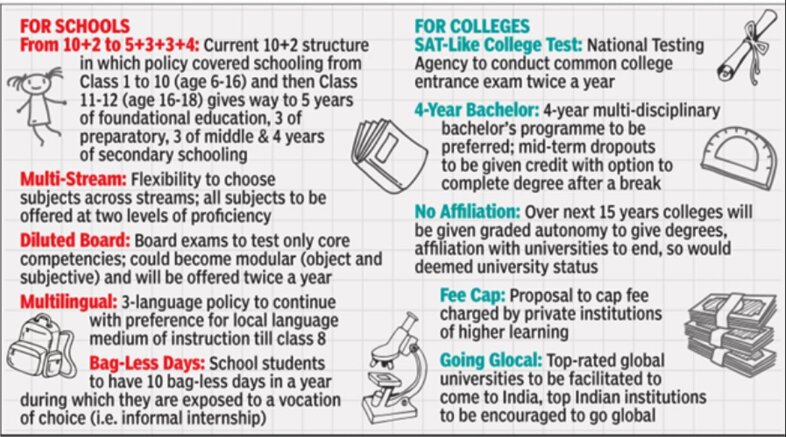Indian Economy
EASE 2.0 Banking Reforms Index
Why in News
Recently, the EASE (Enhanced Access and Service Excellence) 2.0 Banking Reforms Index on performance of Public Sector Banks (PSB) from March 2018-2020 was released and best performing banks on EASE were felicitated.
- Union Minister of Finance & Corporate Affairs also inaugurated Doorstep Banking Services by PSBs on the occasion.
- In February, 2020, EASE 3.0 (2020-21) for smart, tech-enabled banking was also unveiled.
Key Points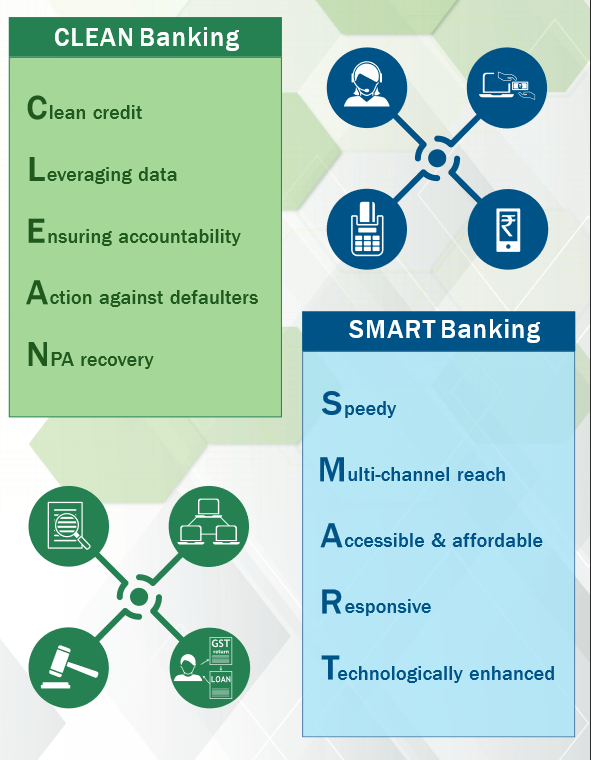
- EASE Reforms Agenda: It was launched in January 2018 jointly by the government and PSBs.
- It was commissioned through Indian Banks’ Association and authored by Boston Consulting Group.
- Indian Banks' Association, formed on 26th September 1946 is an association of Indian banks and financial institutions based in Mumbai.
- EASE Agenda is aimed at institutionalizing CLEAN and SMART banking.
- It was commissioned through Indian Banks’ Association and authored by Boston Consulting Group.
- EASE Reforms Index: The Index measures performance of each PSB on 120+ objective metrics.
- The Index follows a fully transparent scoring methodology, which enables banks to identify their strengths as well as areas for improvement.
- The goal is to continue driving change by encouraging healthy competition among PSBs.
- EASE 1.0 : The EASE 1.0 report showed significant improvement in PSB performance in resolution of Non Performing Assets (NPAs) transparently.
- EASE 2.0 : EASE 2.0 builds on the foundation of EASE 1.0 and introduces new reform Action Points across six themes to make reforms journey irreversible, strengthen processes and systems, and drive outcomes.
- The six themes of EASE 2.0 are -
- Responsible Banking;
- Customer Responsiveness;
- Credit Off-take;
- PSBs as UdyamiMitra (SIDBI portal for credit management of MSMEs);
- Financial Inclusion & Digitalisation; and
- Governance and HR
- The six themes of EASE 2.0 are -
Performance of PSB on EASE 2.0 Index
- Overall Score: Increased by 37% between March-2019 and March-2020, with the average EASE index score improving from 49.2 to 67.4 out of 100.
- Top Performing Banks: Bank of Baroda, State Bank of India, and erstwhile Oriental Bank of Commerce
- Major improvements:
- Digital Banking: Nearly 4 crore active customers on mobile and internet banking.
- 50% of financial transactions through digital channels.
- Customer service: Increase in number of call centres and inclusion of 13 regional languages in customer service, enhanced doorstep banking support by 75,000+ Bank Mitras etc.
- Easy loans: Turnaround time for retail loans reduced by from nearly 30 days to nearly 10 days.
- NPAs and Frauds: Gross NPAs reduced from Rs. 8.96 lakh crore in March-2018 to Rs. 6.78 lakh crore in March-2020.
- A sharp decline in fraud occurrence from 0.65% of advances during FY10-FY14 to 0.06% in FY19-20
- Record recovery of Rs. 2.27 lakh crore in FY19-FY20
- Banks have taken steps like instituting data-driven risk assessments and introducing Early Warning Signals (EWS) systems.
- Digital Banking: Nearly 4 crore active customers on mobile and internet banking.
EASE 3.0
- A comprehensive agenda for smart, tech-enabled banking has been adopted for FY 2020-21, under which PSBs have initiated eShishu Mudra (app-based lending for instant sanction of working capital up to Rs. 50,000) for straight-through processing of loans to micro-enterprises.
- EASE 3.0 seeks to enhance ease of banking in all customer experiences, using technology viz. Dial-a-loan, Partnerships with FinTechs and E-commerce companies, Credit@click, Tech-enabled agriculture lending, EASE Banking Outlets etc.
Doorstep Banking Services
- As part of the EASE Reforms, Doorstep Banking Services is envisaged to provide convenience of banking services to the customers at their doorstep through the universal touch points of Call Centre, Web Portal or Mobile App.
- At present, only non-financial services viz. request for account statement, delivery of cheque book, demand draft, pay order etc are available to customers. Financial services shall be made available from October 2020.
- The services shall benefit all customers, particularly Senior Citizens and Divyangs who would find it at ease to avail these services.
International Relations
Indo-Pacific Trilateral Dialogue
Why in News
Recently, India, Australia and France held a dialogue for the first time under a trilateral framework. The three sides have agreed to hold the dialogue on an annual basis.
Key Points
- Focus: Enhancing cooperation in the Indo-Pacific Region. Australia, along with France, has emerged as a major strategic partner for India in the Indo-Pacific and Indian Ocean Region (IOR), especially in the maritime domain. For instance:
- India has logistics agreements with both countries. The logistics agreement provides for easier access to supplies of goods and services.
- There is significant cooperation in information exchange for Maritime Domain Awareness.
- France was the first country to deploy a Liaison Officer at the Indian Navy’s Information Fusion Centre (IFC-IOR) as part of efforts to improve Maritime Domain Awareness (MDA).
- India conducted its first joint patrols with France in Reunion Island (western Indian ocean) in February 2020.
- Chinese Factor:
- The trilateral cooperation will help to take on China's aggressive behaviour in the Indo-Pacific region. E.g in South China Sea.
- This trilateral cooperation is an addition to the Quad which comprises the USA, Japan, Australia and India.
- It also adds diplomatic muscle to the global coalition that is shaping up to counter China's belligerence.
- Issues Discussed:
- Possibility of enhancing maritime security cooperation between the three countries in the Indo-Pacific region.
- It also includes areas of humanitarian assistance and disaster relief, maritime domain awareness, mutual logistics support and capacity-building of friendly countries.
- Development cooperation in the Indo-Pacific region, initiatives such as the International Solar Alliance and Coalition for Disaster Resilient Infrastructure, and the need for a reformed multilateralism.
- Cooperation on marine global commons. It includes blue economy, marine biodiversity and environmental challenges such as marine pollution.
- Practical cooperation at the trilateral and regional level, including through regional organisations such as Association of Southeast Asian Nations (ASEAN), Indian Ocean Rim Association (IORA) and the Indian Ocean Commission.
- The increased salience of resilient and reliable supply chains.
- India, Australia and Japan recently inked an initiative to build resilient supply chains, which is named as Supply Chain Resilience Initiative (SCRI). France may join this initiative too.
- Emerging challenges in the context of Covid-19 pandemic, including the financial impact of the pandemic on the Indian Ocean region countries.
- Possibility of enhancing maritime security cooperation between the three countries in the Indo-Pacific region.
Significance of the Indo-Pacific Region
- In 2018 Shangrila Dialogue India had clearly indicated the geographical reach of India’s idea of the Indo-Pacific, which starts from Africa to the America, which covers both the Indian and Pacific Oceans, in tandem with that of Japan.
- It is a very rich region in terms of natural resources (fisheries, oil, gas) as well as mineral resources.
- Trade of some of the major economies like China, Japan, Korea or the west coast of the United States goes through this region.
- About 50% of India’s trade is conducted through the South China Sea. India has been one of the major players in the region. India conducts many naval exercises with the United States, countries of ASEAN, Japan, Korea and Vietnam.
- The international community including India wants freedom of navigation, freedom of over flights in the region.
Way Forward
- France and Australia are India’s key partners in the Indo-Pacific region. The meeting provided a unique opportunity to build upon the progress that the three countries have achieved bilaterally in recent years.
Governance
NSO Report on Education
Why in News
Recently, the National Statistical Organisation (NSO) released a report ‘Household Social Consumption: Education in India’, as part of the 75th round of National Sample Survey (July 2017 to June 2018).
- NSO also had released a Report on Health in India based on the same survey.
Key Points
- This is the 6th survey on social consumption relating to education. Earlier, 35th, 42nd, 52nd, 64th, and 71st rounds had surveys on this subject. The 71st round pertained to January-June 2014.
- A sample of 64,519 rural households from 8,097 villages and 49,238 urban households from 6,188 blocks was surveyed all over India.
- This survey covered both qualitative and quantitative aspects related to educational attainment of the household members and educational services used by them.
- Internet access-
- There is a major digital divide within the country across states, cities and villages, and income groups (National Statistical Organisation Survey on Digital Education Divide).
- Nearly 4% of rural households and 23% of urban households possessed computers and 24% of the households in the country had internet access.
- Among persons of age 15-29 years, nearly 24% in rural areas and 56% in urban areas were able to operate a computer.
- Education and Literacy Rates:
- Literacy rate among persons (aged 7 years and above) in India was about 77.7%. In rural areas, the literacy rate was 73.5% compared to 87.7% in urban areas (Report on Literacy Rate).
- Male literacy rate was higher (84.7%) than female literacy rate (70.3%).
- Only 5.7% were graduates or above in rural areas while the percentage was 21.7% in urban areas.
- Access to schools, Attendance, Type of education:
- Only 38% of rural households have secondary schools within 1 km of the house as compared to 70% for urban households.
- In rural areas 92.7% of households and in urban areas, 87.2% of households reported availability of primary school within 1 km from the house.
- 96.1% of students were in general education and remaining were in technical/professional education.
- Gross Attendance Ratio (GAR) at primary level was nearly 100% for both males and females in rural and urban areas.
- For each level of education, GAR is the ratio of the number of persons attending in the level of education (For eg. Class I-V) to the number of persons in the corresponding official age-group (For eg. Total Population of age group 6-10).
- Free education, Scholarships, Stipends:
- At all-India level nearly 14% students attending formal education received scholarship/stipend/reimbursement.
- 77% of the students studying in Government institutions were receiving free education. Percentage of students studying in private unaided institutions and receiving free education was nearly 2% in rural areas and 1% in urban areas.
- At pre-primary level nearly 33% students were getting free education in India. At primary level, the proportion of students receiving free education was 62%
- Private Coachings:
- Nearly 20% of students attending pre-primary and above level were taking private coaching in India.
- Incidence of taking private coaching was maximum at secondary level (31% of male students and 29% of female students).
- Household expenditure on education:
- Average expenditure per student incurred during the current academic session (2017-18) for basic courses was nearly Rs. 8,331 for general courses, Rs. 50,307 for technical/professional courses.
- The average annual expenditure on education for secondary school students is Rs. 9,013, of which Rs. 4,078 goes towards regular school fees.
- About Rs. 1,632, or just over 18%, goes towards private coaching. In higher secondary school, students spend more than Rs. 2,500, also about 18% of the total expenditure, on private coaching.
- Persons currently not attending education:
- In India, percentages of persons in the age group of 3-35 years dropping out of studies were nearly 14% in rural areas and 10% in urban areas.
- For the males of age 3-35 years engagement in economic activities was the most common major reason for currently not attending education, whereas for the females it was engagement in domestic activities.
Key Concerns
- Digital Divide: Online education is yet to develop as a common good and too-much reliance of this mode will only lead to selective reach of education.
- Difference in literacy rate between men and women: This not only leads to increased gender divide but also leads to low participation of women in the workforce and research and development activities. Also, as the reason for women dropping out of schools remains domestic, the deep-ingrained patriarchy in the society is still the major factor behind the gender divide.
- Dependence on private coaching centres for education: This leads to the affluent having more access to education thus increasing the disparities between different social groups. It also comprises the quality of education as the emphasis often shifts to employability only, while the real motive of education should be to enhance critical thinking along with developing skills of the students.
- Heavy Household expenditure: In spite of many government initiatives to promote and improve education in governmental institutions, the cost of education is still very high for a large population to afford. The percentage of students who are receiving free education is still not enough and many needy students are outside its coverage.
- Rural and Urban Divide: The huge differences in some parameters like internet access, ability to use the internet or physical access to schools show that the Urban and rural India have very different conditions. Accordingly, there is a need for separate policies which cater to the separate needs of both, based on local input and community-led approaches.
Way Forward
- With the New Education Policy 2020, we should hope for the education scenario in India to be improved and key concerns to be met. Covid-19 pandemic has necessitated a shift towards online education at a faster pace but the same should be complemented with infrastructure reforms, support and training by the government, aided by civil-society groups.
Source: Findings from NSO Report “Household Social Consumption on Education in India”.
Indian Economy
New FDI Policy in Defence Sector
Why in News
Recently, the Union Cabinet approved a new Foreign Direct Investment (FDI) policy in the defence sector which allows the FDI through automatic approval to be increased from 49% to 74%.
- Earlier, the defence industry can bring FDI up to 49% under the automatic route, and above it under government route.
- However, the new policy has a ‘National Security’ clause as a condition which has been proposed by the Ministry of Commerce and Industry.
Key Points
- National Security Clause: FDI in the defence sector shall be subject to scrutiny on the ground of National Security and the Government reserves the right to review any foreign investment in the defence sector that may affect national security.
- Strengthening Indigenous Manufacturing: Through more liberalised FDI policy the government is seeking to attract foreign players to set up manufacturing units in India.
- It has been focusing on the defence sector to act as an engine for boosting manufacturing in the country, and is aiming to achieve a turnover of Rs 1.75 lakh crore, including exports worth Rs 35,000 crore, by 2025.
- As of 2019, the defence industry, along with the aerospace and shipbuilding industry, was estimated to be worth Rs. 80,000 crore, of which the share of Public Sector Units (PSUs) was nearly 80%.
- The government has brought a draft Defence Production and Export Promotion Policy 2020 (DPEPP 2020), which aims to provide an overarching guiding document to provide a focused, structured and significant thrust to defence production capabilities of the country for self-reliance and exports.
- The government has also brought a negative imports list for defence equipment and a dedicated budget for capital acquisition from the domestic industry.
- The negative imports list contains a list of weapons that will not be imported and can only be purchased from within the country.
- It was done with an aim to reduce the defence import bill.
- The government has inaugurated two defence industrial corridors, in Tamil Nadu and in Uttar Pradesh, to boost the flagship 'Make in India' programme that in turn would attract investments as well as encourage employment generation.
- It has been focusing on the defence sector to act as an engine for boosting manufacturing in the country, and is aiming to achieve a turnover of Rs 1.75 lakh crore, including exports worth Rs 35,000 crore, by 2025.
Foreign Direct Investment
- FDI is an investment made by a firm or individual in one country into business interests located in another country.
- Generally, FDI takes place when an investor establishes foreign business operations or acquires foreign business assets, including establishing ownership or controlling interest in a foreign company.
- It is different from Foreign Portfolio Investment where the foreign entity merely buys equity shares of a company. FPI does not provide the investor with control over the business.
- Routes through which India gets FDI:
- Automatic Route: In this, the foreign entity does not require the prior approval of the government or the RBI.
- Government route: In this, the foreign entity has to take the approval of the government.
- The Foreign Investment Facilitation Portal (FIFP) facilitates the single window clearance of applications which are through approval route.
- This portal is administered by the Department for Promotion of Industry and Internal Trade (DPIIT), Ministry of Commerce and Industry.
Way Forward
- The new FDI policy has the potential to reduce dependency on imports in the defence sector and boost manufacturing in India.
- It will also provide employment and business opportunities to the Indian businesses and boost self-dependency.
Governance
Pradhan Mantri Matsya Sampada Yojana
Why in News
Recently, the Pradhan Mantri Matsya Sampada Yojana (PMMSY) has been digitally launched.
- Several other initiatives in the fisheries and animal husbandry sectors have also been launched on the occasion.
Key Points
- PMMSY is a flagship scheme for focused and sustainable development of the fisheries sector in the country as a part of the Aatmanirbhar Bharat Abhiyan.
- It aims to:
- Adopt ‘Cluster or Area-based Approaches’ and create fisheries clusters through backward and forward linkages.
- Focus especially on employment generation activities such as seaweed and ornamental fish cultivation.
- Address critical gaps in fish production and productivity, quality, technology, post-harvest infrastructure and management, modernisation and strengthening of the value chain, traceability, establishing a robust fisheries management framework and fishers’ welfare.
- Consolidate the achievements of the blue revolution and bring new interventions such as fishing vessel insurance, support for new/up-gradation of fishing vessels/boats, integrated aqua parks, e-trading/marketing, etc.
- Targets:
- Enhance fish production by an additional 70 lakh tonne and increase fisheries export earnings to Rs.1,00,000 crore by 2024-25.
- Double the incomes of fishers and fish farmers.
- Reduce post-harvest losses from 20-25% to about 10%.
- Generate an additional 55 lakhs direct and indirect gainful employment opportunities in the fisheries sector and allied activities.
- Budget and Time Period:
- An estimated investment of Rs. 20,050 crore for a period of 5 years from financial year (FY) 2020-21 to FY 2024-25 in all States/Union Territories.
- This investment is the highest ever in the fisheries sector yet.
- Implementation: It will be implemented as an umbrella scheme with two separate components namely:
- Central Sector Scheme: The project cost will be borne by the Central government.
- Centrally Sponsored Scheme: All the sub-components/activities will be implemented by the States/UTs and the cost will be shared between Centre and State.
Other Inaugurations Related to Animal Husbandry
- e-Gopala App:
- It is a comprehensive breed improvement marketplace and information portal for direct use of farmers.
- It will provide solutions on the aspects of:
- Managing livestock including buying and selling of disease-free germplasm in all forms (semen, embryos, etc.).
- Availability of quality breeding services (Artificial Insemination, veterinary first aid, vaccination, treatment, etc.).
- Guiding farmers for animal nutrition and treatment of animals using appropriate ayurvedic medicine/ethnoveterinary medicine.
- Providing a mechanism to send alerts and inform farmers about various government schemes and campaigns in the area.
- Semen Station:
- The state of the art facility has been established under Rashtriya Gokul Mission in Purnea, Bihar with an investment of Rs. 84.27 crores.
- It is one of the largest semen stations in the government sector with a production capacity of 50 lakh semen doses per annum.
- It will give a new dimension to development and conservation of indigenous breeds of Bihar and meet the demand of semen doses of eastern and northeastern States.
- In vitro fertilization (IVF) Laboratories:
- Various IVF laboratories are being set up across the country through a 100% grant in aid.
- These labs are crucial for propagating elite animals of indigenous breeds and thereby enhancing milk production and productivity manifold.
- Use of Sex-sorted Semen in Artificial Insemination:
- Through this method, only female calves can be produced (with more than 90% accuracy) which will help double the growth rate of milk production in the country.
- Demonstration of IVF Technology at Farmer's Doorstep:
- It will propagate the technology for multiplication of high yielding animals at a faster rate as through the use of technology, a female cattle can give birth to 20 calves in a year.
International Relations
UK Internal Market Bill, 2020
Why in News
The new UK Internal Market Bill has run into controversy over its impact on talks with the European Union (EU) and on international treaties, given it could rewrite parts of the Brexit withdrawal agreement.
Key Points
- About the Bill:
- The bill is designed to “protect jobs and trade” within the UK after the end of 2020’s transition period for leaving the EU.
- Under the withdrawal treaty, a transition period has been finalised until December 2020.
- It will enable the UK government to provide financial assistance to Scotland, Wales, and Northern Ireland and with new powers to spend taxpayers’ money previously administered by the EU.
- It will also empower ministers to pass regulations, specifically on trade and state aid, even if they are contrary to the agreement previously reached with the EU under what is known as the Irish Backstop (earlier known as the Northern Ireland Protocol).
- Irish Backstop is the draft agreement between the UK and the EU that aims to prevent a hard border (limited number of authorised crossing points staffed by customs officers and police) in Ireland after the UK leaves the EU.
- Northern Ireland will become the UK’s only land border with the EU after the transition ends.
- The UK has held that the Bill is needed for a smooth trade between England, Scotland, Wales and Northern Ireland, and will help power recovery from the Covid-19 pandemic.
- The bill is designed to “protect jobs and trade” within the UK after the end of 2020’s transition period for leaving the EU.
- Current System:
- Currently, the UK is a part of the European single market, with jointly agreed regulations and standards right across the continent.
- Post-Brexit, the UK wants to continue to have a joint and “internal market” across England, Scotland, Wales and Northern Ireland.
- Due to Brexit, rules and regulations around things like food and air quality and animal welfare have to be set in the UK only but there is a conflict on who should have the ultimate authority out of the four countries.
- Criticisms:
- Under the EU Withdrawal Treaty, England is meant to cooperate with Brussels (EU’s Headquarter) on any arrangements for Northern Ireland and not decide on such matters all by itself.
- Scotland holds that the new Bill is a just a power-grab by England from the devolved administrations in Scotland itself, Wales and Northern Ireland.
- All four nations will have to accept goods at the standards set in any one country so there are fears local quality controls could be dragged down to the lowest common denominator if England sets any such standard which is not practical or profitable for the rest of the three countries.
- Furthermore, under the current proposals, any disputes would be settled by a new Office for the Internal Market.
- This might be envisioned as an independent third party forum, but the devolved administrations see it as being another example of decisions being taken out of their hands.
Governance
VIP Security in India
Why in News
Recently, the Ministry of Home Affairs (MHA) has provided Y-plus category of CRPF security to an actress.
Key Points
- VIP Security:
- This protection is informally called “VIP security”, and it is generally given only to someone who holds a position of consequence either in the government or in civil society.
- Certain individuals, by reason of positions they hold in government, are automatically entitled to security cover. They include:
- The Prime Minister and his immediate family.
- The Home Minister.
- Officials such as the National Security Advisor.
- Certain individuals, by reason of positions they hold in government, are automatically entitled to security cover. They include:
- In cases where the central government decides to extend security to an individual, the level of security needed by any individual is decided by the MHA, based on inputs received from intelligence agencies which include the Intelligence Bureau (IB) and Research and Analysis Wing (R&AW).
- Confidential Inputs: The intelligence inputs that these agencies generate, particularly in cases where VIP security is involved, is neither put out in the public domain nor is it open to scrutiny by any other agency.
- Concern due to lack of Accountability:
- Indian intelligence agencies are not accountable to any statutory body, and are subject only to the internal oversight of the MHA and the Ministry of External Affairs (MEA).
- Because of this opacity in functioning, and the fact that there is virtually no accountability except to the government in power, VIP security is open to manipulation by the executive.
- A large number of protectees, it has been alleged, are under security cover purely for political or “prestige” reasons, and not necessarily because of any genuine threat.
- This protection is informally called “VIP security”, and it is generally given only to someone who holds a position of consequence either in the government or in civil society.
- Levels of Protection:
- There are broadly six categories of security cover: X, Y, Y-plus, Z, Z-plus, and SPG (Special Protection Group).
- The SPG is meant only for the Prime Minister and his immediate family, other protection categories can be provided to anyone about whom the Centre or state governments have inputs of a threat.
- There are various kinds of security cover even within these levels. These include
- Security of residence,
- Mobile security,
- Office security, and
- Inter-state security.
- The number of personnel guarding the protectee differ from category to category.
- The X category on average entails just one gunman protecting the individual. The X category is the most basic level of protection.
- Z-plus category protectees have 10 security personnel for mobile security, and two (plus 8 on rotation) for residence security.
- Different Forces Involved:
- Protectees get residence security from state police, but mobile security from a Central Armed Police Force (CAPF).
- Central Armed Police Forces of India is a group of forces (under the Ministry of Home Affairs) for internal security. It includes the CRPF, CISF, ITBP, etc.
- For VIPs other than the PM, the government has mandated the National Security Guard (NSG), Central Reserve Police Force (CRPF) and the Central Industrial Security Force (CISF) to provide security cover.
- The government has intended over the years to reduce the burden of VIP security on the NSG, because the core function of the NSG is counter-terrorism operations, not providing VIP security.
- It is for this reason that the Home Minister and NSA have been given CRPF and CISF cover respectively.
- Protectees get residence security from state police, but mobile security from a Central Armed Police Force (CAPF).
- Paying for the Protection:
- On Assessment by the Intelligence Agencies: Anyone to whom the government provides security after assessment by intelligence agencies, gets the protection for free.
- However, those who have an elaborate security cover such as those in the Z and Z-plus categories, may have to consider accommodation for these security personnel on their own.
- Private Individuals: Those who apply for the security but their case is not having consequences on the government and civil society, the government can charge a private individual for their security cover even after assessing a threat to them.
- On Assessment by the Intelligence Agencies: Anyone to whom the government provides security after assessment by intelligence agencies, gets the protection for free.
Governance
Aatmanirbhar Bharat ARISE-Atal New India Challenge
Why in News
The Aatmanirbhar Bharat ARISE-Atal New India Challenge (ANIC) Program, launched by the government, is a national initiative to promote research & innovation and increase competitiveness of Indian startups and Micro, Small and Medium Enterprises (MSMEs).
Key Points
- Objective: To proactively collaborate with Ministries and the associated industries to catalyse research, innovation and facilitate innovative solutions to sectoral problems.
- The objective is also to provide a steady stream of innovative products & solutions where the Central Government Ministries/Departments will become the potential first buyers.
- Administration:
- The initiative will be carried under the Atal Innovation Mission (AIM - an initiative by the NITI Aayog).
- The programme will be driven by Indian Space Research Organization (ISRO) and four ministries:
- Ministry of Defence;
- Ministry of Food Processing Industries;
- Ministry of Health and Family Welfare; and
- Ministry of Housing and Urban Affairs.
- Features:
- The initiative will help promote techno-preneurs who deserve to be supported because of their immense potential of taking India forward.
- A total of 15 sector-specific challenges will be selected where three challenges are kept for each ministry.
- A grant-of-aid of up Rs. 50 lakh for a period of 9 to 12 months have been earmarked for startups to develop a minimum usable prototype.
- Innovators would also be attracted by using the Mahatma Gandhi Challenge method.
- On the 150th birth Anniversary of Mahatma Gandhi, ‘the Gandhian Challenge’ was launched.
- It provides a platform for every child across India to ideate innovative solutions for a sustainable India of their dreams, using Gandhi’s principles.
- Broad categories in the challenge: Art & Innovation and Science, Technology & Innovation.
- The Program is in line with the mandate of:
- “Make in India”
- “Startup India”
- “Aatmanirbhar Bharat”
- Role of the Indian Space Research Organisation :
- ISRO is the leading organization to promote innovations and entrepreneurship across the length and breath of our country.
- ISRO has extensively supported MSMEs and has also set up R&D labs across India to promote innovation and research in space science and technology.
- ISRO is planning to adopt 100 Atal Tinkering Labs, 3 each in each state and UTs.
- Three thrust areas identified by ISRO:
- Propulsion: Green propellants, electric propulsion, and advanced air-breathing.
- Geo-spatial Information: Using Artificial Intelligence (AI) for crop monitoring, weather forecasting and programme evaluation.
- AI and Robotics: For supporting space exploration and outer space monitoring.
Importance of MSMEs for Indian Economy
- They are considered as the engine of growth in an economy.
- Employment: It is the second largest employment generating sector after agriculture. It provides employment to around 120 million persons in India.
- Contribution to GDP: With around 36.1 million units throughout the geographical expanse of the country, MSMEs contribute around 6.11% of the manufacturing GDP and 24.63% of the GDP from service activities.
- MSME ministry has set a target to up its contribution to GDP to 50% by 2025 as India becomes a $5 trillion economy.
- Exports: It contributes around 45% of the overall exports from India.
- Inclusive growth: MSMEs promote inclusive growth by providing employment opportunities in rural areas especially to people belonging to weaker sections of the society.
- Financial inclusion: Small industries and retail businesses in tier-II and tier-III cities create opportunities for people to use banking services and products.
- Promote innovation: It provides opportunity for budding entrepreneurs to build creative products boosting business competition and fuels growth.
Atal Innovation Mission
- AIM is Government of India’s flagship initiative to promote a culture of innovation and entrepreneurship in the country.
- It’s objective is to develop new programmes and policies for fostering innovation in different sectors of the economy, provide platform and collaboration opportunities for different stakeholders, create awareness and create an umbrella structure to oversee the innovation ecosystem of the country.
- Major Initiatives:
- Atal Tinkering Labs: These are creating problem solving mindset across schools in India.
- Atal Incubation Centers: Fostering world class startups and adding a new dimension to the incubator model.
- Atal New India Challenges: Fostering product innovations and aligning them to the needs of various sectors/ministries.
- Mentor India Campaign: A national mentor network in collaboration with the public sector, corporates and institutions, to support all the initiatives of the mission.
- Atal Community Innovation Center: To stimulate community centric innovation and ideas in the unserved/underserved regions of the country including Tier 2 and Tier 3 cities.
- Atal Research and Innovation for Small Enterprises (ARISE): To stimulate innovation and research in the MSME industry.
Geography
Typhoon Maysak and Typhoon Haishen
Why in News
Recently, Korean Peninsula and Japan were hit by two typhoons named Maysak and Haishen.
Typhoons
- Typhoons are a kind of storm. The storms, depending on where they occur, may be called hurricanes, typhoons or cyclones.
- Typhoons: In the China Sea and Pacific Ocean.
- Hurricanes: In the West Indian islands in the Caribbean Sea and Atlantic Ocean.
- Tornados: In the Guinea lands of West Africa and southern USA.
- Willy-willies: In north-western Australia and
- Tropical Cyclones: In the Indian Ocean Region.
- The scientific name for all these kinds of storms is tropical cyclones.
- Tropical cyclones are intense circular storms that originate over the warm tropical oceans with speed more than 119 kilometres per hour and heavy rains.
Key Points
- Categorisation: Both typhoons were categorised as a Category 4 hurricane storm.
- A Category 4 storm has wind speeds between 130-156 mph and can uproot trees and bring down power lines.
- Hurricanes are categorized on the Saffir-Simpson Hurricane Wind Scale, which rates them on a scale of 1 to 5 based on wind speed. Hurricanes that reach category three or higher are classified as major hurricanes.
- Naming: The Maysak typhoon takes its name from a Cambodian word for a type of tree. While, Haishen means sea god in Chinese.
- Typhoon Maysak and Haishen are referred to as typhoon number 9 and 10 in Japan.
- Background of Naming:
- In Japan the first typhoon to occur after January 1st of the year is called typhoon number 1.
- In the USA, hurricanes are referred to by English names.
- The intergovernmental organisation called the Typhoon Committee which has 14 members including Japan, USA and China uses Asian names for typhoons that are contributed by the member countries.
- Haishen was a name recommended by China, while Maysak is a Combodian name.
Important Facts For Prelims
Shikshak Parv
Why in News
Shikshak Parv is being celebrated from 8th-25th September 2020 to felicitate the teachers and to take New Education Policy (NEP) 2020 forward.
Key Points
- Under the Shikshak Parv initiative, the Ministry of Education is organizing a series of webinars on NEP and its implementation.
- Teachers’ Day is celebrated on 5th September every year throughout India in memory of Dr. Sarvapalli Radhakrishnan on his birth anniversary.
- Radhakrishnan was born in a family in Tiruttani (Tamil Nadu) in 1888.
- He has played many roles in his life. He has been a teacher, philosopher, author and politician. He was the first Vice President of India (1952–1962) and the second President of India from 1962 to 1967.
- He was awarded knighthood in 1931. In 1954, he was awarded Bharat Ratna, the highest civilian award in India. He got honorary membership of the British Royal Order of Merit in 1963.
- World Teachers’ Day is celebrated on 5th October annually to commemorate the anniversary of the adoption of the 1966 ILO/UNESCO Recommendation concerning the Status of Teachers.
- This instrument sets forth the rights and responsibilities of teachers, and standards for their initial preparation and further education, recruitment, employment, teaching and learning conditions.
- New Education Policy (NEP) 2020:
- This policy aims to pave the way for transformational reforms in school and higher education systems in the country. This policy replaces the 34 year old National Policy on Education (NPE),1986.
- NEP 2020 is aligned to the 2030 Agenda for Sustainable Development. It is built on the foundational pillars of Access, Equity, Quality, Affordability and Accountability.
- An autonomous body, the National Educational Technology Forum (NETF), is proposed to provide a platform to facilitate decision making on the induction, deployment, and use of technology, as well as the opportunity to consult and share best practices.

